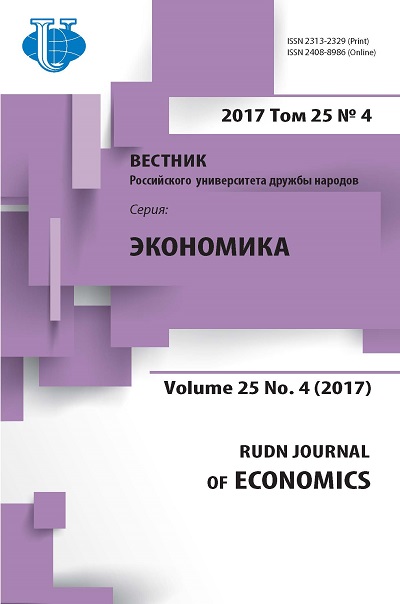Influence of smart grid and renewable energy sources on energy efficiency: foreign experience
- Authors: Matyushok VM1, Sergio B.2, Balashova SA1, Gomonov KG1
-
Affiliations:
- Peoples Friendship University of Russia
- Harvard University
- Issue: Vol 25, No 4 (2017)
- Pages: 583-598
- Section: Articles
- URL: https://journals.rudn.ru/economics/article/view/18233
- DOI: https://doi.org/10.22363/2313-2329-2017-25-4-583-598
Cite item
Full Text
Abstract
The article analyzes foreign influences on energy efficiency of such factors as raising the level of energy production from renewable sources and introducing smart technologies in power networks. Econometric analysis of experience in increasing energy efficiency of the United States, China, India, and Germany in comparison with Russia has been performed using a number of hypotheses to construct models. The necessity of transition to a new energy structure based on active introduction of energy efficient equipment, advanced energy and information and communication technologies, renewable energy sources, complex systems and services of intellectual energy built on an open network architecture is substantiated.
About the authors
V M Matyushok
Peoples Friendship University of Russia
Author for correspondence.
Email: vmatyushok@mail.ru
Dr. Econ. Sci., Full Professor, Director of the International Center for Emerging Market Research, Head of the Department of Economic and Mathematical Modeling of the Faculty of Economics
6, Miklukho-Maklaya str., Moscow, Russia, 117198Bruno Sergio
Harvard University
Email: bsergi@fas.harvard.edu
Professor, researcher at the Davis Center for Russian and Eurasian Studies Harvard University,Cambridge, USA
Massachusetts Hall, Cambridge, MA 02138S A Balashova
Peoples Friendship University of Russia
Email: balashova_sa@rudn.university
Cand. Physico-math. Sci., Associate Professor of the Department of Economic and Mathematical Modeling, Deputy Director of the International Center for Emerging Market Research
6, Miklukho-Maklaya str., Moscow, Russia, 117198K G Gomonov
Peoples Friendship University of Russia
Email: gomonov_kg@rudn.university
Cand. Econ. Sci., Senior Lecturer of the Department of Economic and Mathematical Modeling of the Department of Economics
6, Miklukho-Maklaya str., Moscow, Russia, 117198References
- Statisticheskie dannye Vsemirnogo banka. URL: https://data.worldbank.org/country (accessed: 13.08.2017) (In Russ).
- Allcott, H., & Greenstone, M. (2013) Is There an Energy Efficiency Gap? In Energy Efficiency. Towards the End of Demand Growth. P. 133—161.
- Dent C. (2013) Wind energy development in East Asia and Europe. Asia Europe Journal. Vol. 11. Issue 3. P. 211—230.
- Aivazyan S.A. (2014) Metody ekonometriki. М.: Infra-M. (In Russ).
- Nosko V.P. (2002) Vvedenie v analiz vremennykh ryadov. Moskva. (In Russ).
- Programmy razvitiya vozobnovlyaemoi energetiki, soglasno dannym Mezhdunarodnogo energeticheskogo agentstva. URL: https://www.iea.org/policiesandmeasures/renewableenergy/ (accessed: 20.07.2017) (In Russ).
- New Energy Outlook 2017 (NEO 2017). URL: https://data.bloomberglp.com/bnef/sites/14/2017/06/ BNEF_NEO2017_ExecutiveSummery.pdf?elqTrackId=431b316cc3734996abdb55ddbbca0249&elq=eff26d245c8345158dc1cc5d51cd2172&elqaid=7785&elqat=1&elqCampaignId (accessed: 19.09.2017).
- Golikov I.V. (2017) Novye energosberegayushchie tekhnologii. Nauchno-obrazovatel’nyi potentsial molodezhi v reshenii aktual’nykh problem XXI veka. No. 7. S. 211—214.
- SShA kurs na ehnergosberezhenie i ehnergoehffektivnost. URL: http://www.webeconomy.ru/index. php?page=cat&newsid=2872&type=news (accessed: 10.09.2017).
- Dmitriev S.S. (2014) Energeticheskaya strategiya B. Obamy: opora na innovatsii i tekhnologicheskoe liderstvo. M.: IMEMO RAN. 162 s. (In Russ).
- Balashova S.A., Shpolyanskaya A.A. (2015) Administrativnye i ekonomicheskie mekhanizmy obespecheniya innovatsionnogo razvitiya (opyt Germanii i skandinavskikh stran). Natsional’nye interesy: prioritety i bezopasnost’. No. 47. S. 53—66. (In Russ).
- Loschi, H.J., León, J., Iano, Y., Filho, E.R., Conte, F.D., Lustosa, T.C., & Freitas, P.O. (2015) Energy Efficiency in Smart Grid: A Prospective Study on Energy Management Systems. Smart Grid and Renewable Energy. No. 06(08). P. 250—259.















